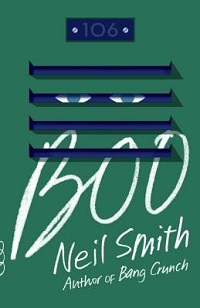| ________________
CM . . .
. Volume XXII Number . . . .September 25, 2015
excerpt:
This opening paragraph of Neil Smith’s brilliant novel Boo introduces key information. Thirteen-year-old Oliver Dalrymple, nicknamed Boo, is dead and “living” in heaven. He attempts to record his experiences for his much-loved, and missed mother and father, including his propensity to understand things through science. Having woken up in Town, the afterlife space specifically for 13-year-old Americans, Boo tries to understand and adjust to his sudden death which he assumes to have been caused by a heart defect. This assumption is challenged by the arrival of Johnny, a former classmate killed at the same time and in the same place as Boo. Together, they try to figure out what happened and what might happen next. This novel was fascinating to read. Smith develops an alternative notion of “heaven” that is age and geographically distinct. It is implied that elsewhere there may exist a similar space for other groups, 14-year-old Canadians, for example. Once arriving in Town for the required fifty-year stay, inhabitants do not change physically but do mature in other ways. Oliver has found himself becoming less intellectual and more social as he negotiates his new home. Smith uses Oliver’s observation and questioning nature to help the reader make sense of the setting. Oliver conducts experiments to discover that buildings and people can heal in town, that supplies arrive with particular rules, and that “Zig”, the benevolent God often messes up. The description of this space and the rules that govern it encourage questions about faith, religion, and identity. As well as the thought-provoking setting, Oliver and Johnny’s journey to understand their deaths presents the complexity of mental illness, bullying, victim and victimizer. The plot twists and turns as the characters piece together what may have happened that fateful day in the halls of Helen Keller Junior High on September 7, 1979. In Johnny, Oliver finds friendship that escaped him in his first life. This friendship is tested as each of them must decide what sacrifices they will make for each other and how they will forgive. I was so engaged in this book because of the development of the characters, the setting, the multiple plot lines and also because Smith treats his readers with such respect. Boo encourages deep thinking about complex issues and never lets the reader get away with sweeping assumptions. Boo is a book that needs revisiting and rereading. Highly Recommended.
Karen Boyd is Assistant Superintendent- Educational Programming with the River East Transcona School Division in Winnipeg, MB, and a former sessional lecturer in YA literature at the Faculty of Education, the University of Manitoba.
To comment on this title or this review, send mail to cm@umanitoba.ca.
Copyright © the Manitoba Library Association. Reproduction for personal use is permitted only if this copyright notice is maintained. Any
other reproduction is prohibited without permission.
CM Home |
Next Review |
(Table of Contents for This Issue - September 25, 2015.)
| Back Issues | Search | CM Archive
| Profiles Archive |
